What would Italy be like if the Christian religion had forbidden the creation of paintings, frescoes and statues that tell its stories? And why did they build so many churches when the population must have been so small? By chance, I read Ken Follett’s Pillars of the Earth my first two weeks here, which gives lots of background on the social, political and economic context for the building of great cathedrals in 12th century England. Similar factors must have been operating in Italy, when temporal and spirital power overlapped much more.
I reckon nowhere on this planet comes close to the delights of Italy, if history-soaked architecture and art combined with cultural largesse and people with style to burn and attitude to match are the benchmark. Umbria in central Italy provides a setting molto conducive to learning, in a spirit of amazement and appreciation. Best sampled indiscriminately with a vino di casa, crunchy bread and any gorgonzola at all.
The Italians make Aussie dress conventions seem exceedingly bland. Where else do men flaunt green pants and orange suits:
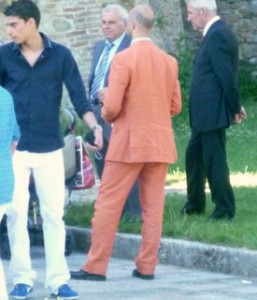
The landscape alone is too beautiful to ignore. It is easy to imagine medieval battles in the lush landscape, rolling hills and valleys. From the top of town you can see Assisi glittering like a jewel, about 20 KM away:
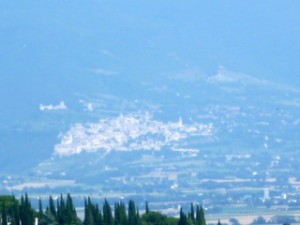
Central Italy is also very modern, with important notable exceptions. They have worked out that they can control the access of all the little cars that want to zoom along narrow steep streets by placing electronic, remote controlled bollards. These sink into the cobblestones when an authorised resident clicks:
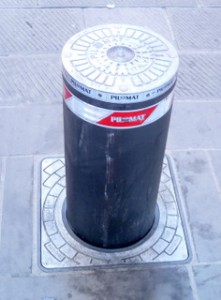
Traffic is a serious problem. Several pedestrians died in Perugia during our time here, as the cars don’t give a ‘fregga’ and zip down narrow streets, and all too often they park on what could serve as a footpath. This forces walkers to criss-cross the street several times in a few hundred metres, just to be off the narrow road. Even though the flat we rented faces an ancient wall, the din of traffic on both sides of the building makes for lost sleep and would certainly be unacceptable for a longer stay. I thought longingly of quiet Canberra when the Italian news reported that Australia has been rated the most pleasant place to live, whereas Italy only came 24th,. I also don’t envy them being forever inundated with tourists, a fate unlikely to arrive in Australia’s cities, especially the ACT, anytime soon.
Some Italians understand the challenges, living with historic accommodation as they do. Spoletto has the goal of becoming a ‘car free’ city, and has an amazing set of at least 7 interconnected escalators to take visitors up to the fortress. Perugia is rightfully proud of its two year old Mini-Metro, which makes it possible for outlying suburbs to reach the historic centre. It is a beautifully engineered mix of funicular railway, airport terminal shuttle, light rail, and amusement park ride, but more convenient and much cuter:
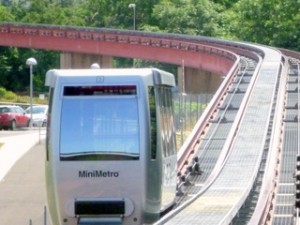
A recent feature in the Economist magazine made the mild claim that Australia lacks the leadership or vision needed for real development. I couldn’t help but wonder why Perugia, built on a steep hill with world heritage class historical buildings, has been able to build a modest, but expandable metro with only 160,000 residents. Canberra, on the other hand, with more than twice the population and the capital of a rich country, can’t set the pace for either public transport, renewable energy, or a low carbon economy, even with the Greens holding the balance of power. Sleepers, whaa?
But then another issue ran a special report on Italy, with an even more scathing assessment. The Economist is valuable because it gives the context of current events, not just the immediate news. For Italy, their history does indeed hold them back, but only because they let it. They are still kind of mediaeval in many of their restrictive work practices and have low productivity as a result. Two serious problems are getting rid of the garbage in Naples and their Prime Ministerial Palace. Reports of Mafia dumping of toxic waste in the south don’t help either.
My excuse for spending a month in Perugia was to brush up on my Italian at the University for foreigners. The class had a mixture of young people from Libya, China, Japan, Kazakhstan, Romania, Bosnia, the US and Armenia. It was comforting that there were also a handful of older women like myself, from northern European countries. Like me, the Germans and Swiss women always arrived early for class, with completed exercises and textbooks open. Some traits must be genetic.
Hard to say how gob-smacking the place is, in addition to the challenges of a somewhat weird and irrational culture. How can they put out a text book that has two sets of alphabetic listings for the same conjugation of verbs, so that you have to look for each in the index and then go to a specific page?
This chaotic thinking probably comes from the wondrous convoluted streets and long flights of stairs lead to the ancient Centro, too picturesque after a while to warrant another photo. Layer upon layer of fumbling, building, repairing and replacing have to be expected in a place that has been continually inhabited for about 2400 years. Some places were ‘renovated’ in the 1400s. We found out that the Etruscians used travertine, and the Romans used limestone, and that is how to start distinguishing them in the walls and oldest buildings. The building for my uni was next to an Etruscian arch, which itself had Rennaissance additions:
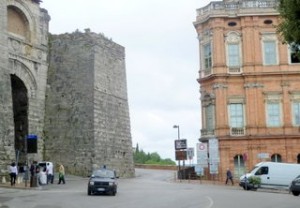
The effort of attending classes and doing homework was certainly lightened by attending classes in a palace, even if air con hasn’t arrived yet:
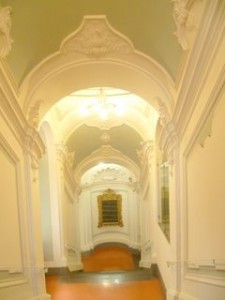
Like so many other buildings here, it has a history, additions, modifications and great charm. Providing modern accoutrements and maintaining the crumbling bits has to be a major industry in Italy. The Palazzo Gallenga has furniture that is clearly recent, but fits totally into the style and colours of the older décor:
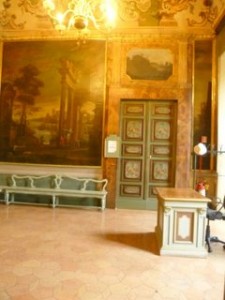
And even mundane items like garden taps show design detail and thought that we would never consider in Australia:
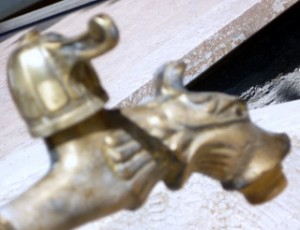
A few years ago, visiting Rome, I thought Italy has become a captive to its past. Now, on closer acquaintance, I see that they are part of that history, and are constantly building on the beauty and lessons of their past. Perugia was a ‘commune’ or free city before the ink was dry on the Magna Carta. But today they have a few modern problems, including unemployment in the ever poor south, but could still avoid Greece’s fate.
Even in Italy it seems impossible to escape the image of Che Guevara. It confronted me in a poster for a ‘slow food revolution’, which has (slowly) found its way to Perugia:
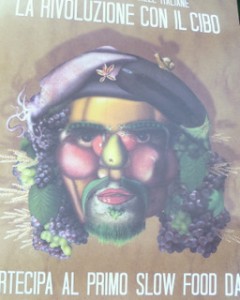
The cultural offerings also made us wonder what the underlying funding model might be. Pretty much every night there were concerts, or musical performances, usually in gorgeous but very old oratoria, churches, public buildings or palazzi. For free, or just a tiny donation. What can it be like, to be a young person growing up in this enormous richness, playing great saxaphone pieces surrounded by 16th century frescoes and baroque gilt?
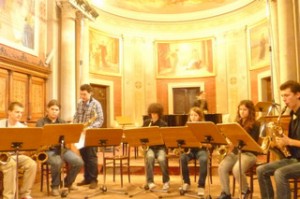
Hearing Italians, not to mention the delight of joining in the fray, is as delicious as the pastry. Speaking Italian, even at my medicore level, is another local sensual pleasure. The Chinese know how much fun Italy is – they are here in droves, and chatter away in Italian while they run shops, study opera, and sell clothes at the markets. One of the teachers said the Chinese girls arrive in conservative clothes, and after a week are kitted out in short skirts and groovy bags. You can hardly tell them from the Italians, except that the Italians have enviably booffy hair.
During conversation class, the teacher asked a Chinese student what his religion is. He replied ‘Communism’, to general chuckles. But it seems to me that one factor in Chinese success is that they are not saddled with dysfunctional religious rituals, obligations and animosities. The Chinese girls, unlike their Arab counterparts here, aren’t sweltering under head scarves and long garments in the summer heat. It is possible to enjoy the art without accepting the religious premises. But this image on a satellite dish made me pause: perhaps it was a sign? Perhaps a conversion was in order, given how impressive the whole setting is? Or maybe the Italians are just using another marketing opportunity:
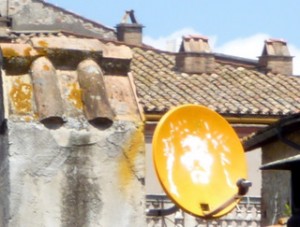
Wonderful tale, I wish I was there, but i could see all the buildings in my minds eye, it reminds me of a trip long ago. I spent a couple of weeks in a hospital and that was a cultural experience…wine with lunch and dinner. If not cured then very happy. Have fun and love the photos.
Comment by Annette Hood — July 1, 2011 @ 6:48 am
I wish I was there too. Enjoyed the cultural descriptions and insights.
Comment by Peter Strang — July 2, 2011 @ 11:18 am
You certainly made the most of your time in Perugia, the richness of cultural events must be almost overwhelming. We found much too in our stay in Southern Germany years ago with freuqent free organ concerts in the churches, etc.
Not all the Chinese are in Italy. We have found that there are quite a number on working holidays in the Kimberley, staffing the supermarkets and so on.
Your photo of the rather different satellite dish reminds me that there is a firm here in Derby for such things called “Let us do your dishes.
Comment by Del — July 10, 2011 @ 7:14 am
Why users still use to read news papers when in this technological world everything is available on web?
Comment by wow gold — April 21, 2013 @ 10:42 pm
Basically, everywhere where there are lots of people or items that need to
be cooled can benefit from one of the portable air
conditioning units available. That’s where desiccant dehumidification comes into the picture. Clean your gloves with lukewarm water and squeeze out the excess water.
Comment by los angeles drunk driving attorney — May 16, 2013 @ 8:20 am